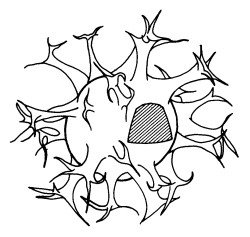Difference between revisions of "Achomosphaera neptuni"
From dinoflaj3
| (One intermediate revision by the same user not shown) | |||
| Line 1: | Line 1: | ||
| − | <B><I>neptuni</I></B> ([[Eisenack, 1958a]], p.399, pl.26, figs.7 | + | <B><I>neptuni</I></B> ([[Eisenack, 1958a]], p.399, pl.26, figs.7–8; text-fig.8) [[Davey and Williams, 1966a]], p.51–52. Emendations: [[Duxbury, 1983]], p.55, as <I>[[Spiniferites neptuni]]</I>; [[Sarjeant, 1985a]], p.89–90,92, as <I>[[Florentinia neptuni|Florentinia]]</I>? <I>[[Florentinia neptuni|neptuni]]</I>. Holotype: [[Eisenack, 1958a]], pl.26. fig.7. Originally <I>[[Baltisphaeridium neptuni Appendix A|Baltisphaeridium]]</I> (Appendix A), subsequently (and now) <I>Achomosphaera</I>, thirdly <I>Achomosphaera</I>?, fourthly <I>[[Spiniferites neptuni|Spiniferites]]</I>, fifthly <I>[[Florentinia neptuni|Florentinia]]</I>?. Questionable assignment: [[Stover and Evitt, 1978|Stover and Evitt (1978]], p.139) — however, [[Lister and Batten, 1988b|Lister and Batten (1988b]], p.31–32) retained this species in <I>Achomosphaera</I> without question. Since the epithet is based on a familiar name with an existing Latin genitive, it ends in "i" rather than "ii" (I.C.N. Recommendation 60C.2). Age: Early Cretaceous. |
[[Category:Index2016]] | [[Category:Index2016]] | ||
| + | [[Category:HasImage]] | ||
<BR><CENTER>[[Image:Achomosphaera_neptuni.jpg|link=]]</CENTER> | <BR><CENTER>[[Image:Achomosphaera_neptuni.jpg|link=]]</CENTER> | ||
Latest revision as of 14:10, 30 December 2016
neptuni (Eisenack, 1958a, p.399, pl.26, figs.7–8; text-fig.8) Davey and Williams, 1966a, p.51–52. Emendations: Duxbury, 1983, p.55, as Spiniferites neptuni; Sarjeant, 1985a, p.89–90,92, as Florentinia? neptuni. Holotype: Eisenack, 1958a, pl.26. fig.7. Originally Baltisphaeridium (Appendix A), subsequently (and now) Achomosphaera, thirdly Achomosphaera?, fourthly Spiniferites, fifthly Florentinia?. Questionable assignment: Stover and Evitt (1978, p.139) — however, Lister and Batten (1988b, p.31–32) retained this species in Achomosphaera without question. Since the epithet is based on a familiar name with an existing Latin genitive, it ends in "i" rather than "ii" (I.C.N. Recommendation 60C.2). Age: Early Cretaceous.
